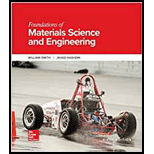
Concept explainers
a)
The total percent of cold work has to be determined.
a)
Answer to Problem 61AAP
The total percent of cold work is 39 %.
Explanation of Solution
Write the expression for the initial cross sectional area of the wire.
Here, initial diameter of the wire is
Write the expression for the final cross sectional area of the wire.
Here, final diameter of the wire is
Write the expression for the percentage of cold reduction:
Here, initial thickness of the sheet is
Conclusion:
Substitute equation (I) and (II) in equation (III)
Substitute 20% for
Substitute 3.13 mm for
Thus, the total percent of cold work that wire undergoes is 39%.
b)
Tensile strength, yield strength, and elongation have to be estimated.
b)
Answer to Problem 61AAP
Ultimate tensile strength
Yield strength
Elongation
Explanation of Solution
Refer the figure 6.44, to obtain a tensile strength, yield strength, and elongation for 40 percent of cold work as given as follows:
Ultimate tensile strength
Yield strength
Elongation
Thus, the Ultimate tensile strength, Yield strength, and Elongation of the alloys is 38 ksi, 33 ksi, 8% respectively.
Want to see more full solutions like this?
Chapter 6 Solutions
FOUND.OF MTRLS.SCI+ENGR.(LL)-W/CONNECT
- (a) A 20 cm long bar (10 mm by 10 mm cross-section) of pure aluminium (Young's modulus = 70 GPa) is subjected to tensile loading. If the bar yields at a load of 14,000 N, what is the maximum elongation at the onset of permanent deformation?(b) For the same bar, if the engineering strains are 0.05 and 0.10 at engineering stresses of 200 and 220 MPa respectively, what would be the work hardening exponent of pure aluminium?arrow_forwardA cylindrical brass rod with a minimum tensile strength of 450 MPa, a ductility of at least 13% EL (elongation), and a final diameter of 12.7mm is required. You have in your inventory some 19.0mm diameter brass stock that has been cold worked to 35%. Assuming that the cross section of the rod is still circular after being cold worked, and that brass experiences cracking at 65% CW, describe the necessary working steps in order to achieve the final product. Take the expression for % cold work to be = (Ao - Af)/ Ao x 100%, where Ao and Af are the original and final circular cross-sectional areas of the rod.arrow_forwardWhy do some Brittle materials, fracture suddenly? Give one example?arrow_forward
- For pure aluminum (Tm = 660 °C), how is plastic deformation at elevated temperature (for example, 450 °C) affected compared to room temperature?arrow_forwardA 20 foot long x 4 feet wide x ½ inch thick sheet of an aluminum alloy is cold rolled to a thickness of ¼ inch. During the rolling operation the with of the sheet increases by 10%. The strength coefficient (K) and the strain hardening coefficient (n ) for the aluminum alloy are 25,500 psi and 0.3, respectively Calculate the true strain at the end of the rolling process.arrow_forwardWhat is G-P zone? Draw yield stress vs. aging time, use a simple sketch andexplain the mechanism. Why does yield stress change by aging time ?arrow_forward
- The lower yield point for a certain plain carbon steelbar is found to be 135 MPa, while a second bar of the samecomposition yields at 260 MPa. Metallographic analysisshows that the average grain diameter is 50μm in the firstbar and 8μm in the second bar.a. Predict the grain diameter needed to cause a loweryield point of 205 MPa.b. If the steel could be fabricated to form a stablegrain structure of 500 nm grains, what strengthwould be predicted?c. Why might you expect the upper yield point to bemore alike in the first two bars than the lower yieldpoint?arrow_forwardExplain strain hardening. Is this mechanism heat resistant? explainarrow_forwardExplain what the meaning of strain hardening is, how it happens in the materials. Do you think strain hardening is useful? Explain your answerarrow_forward
- Ordinary sheets of borosilicate glass are tested in bending, and are found to fracture at an average stress of 72 MPa. After thermal tempering, the stress at failure increases by 90%. What are the sign and magnitude of the stress induced in the glass by the tempering operation?arrow_forwardA batch of casted mild steel has a modulus of elasticity of 200 GPa and a yield strength of 250MPa. Calculate for its modulus of resilience. After cold working the steel, the yield strength increases to 310 MPa. Calculate for the percent reduction in the average grain diameter given σo =70 MPa and k = 0.74.arrow_forwardA tensile stress of 9000 psi and a shear stress of 4000 psi are induced in a brittle material whose working strength in straight tension is 10500 psi. What is the maximum tensile (axial) stress?arrow_forward
 Elements Of ElectromagneticsMechanical EngineeringISBN:9780190698614Author:Sadiku, Matthew N. O.Publisher:Oxford University Press
Elements Of ElectromagneticsMechanical EngineeringISBN:9780190698614Author:Sadiku, Matthew N. O.Publisher:Oxford University Press Mechanics of Materials (10th Edition)Mechanical EngineeringISBN:9780134319650Author:Russell C. HibbelerPublisher:PEARSON
Mechanics of Materials (10th Edition)Mechanical EngineeringISBN:9780134319650Author:Russell C. HibbelerPublisher:PEARSON Thermodynamics: An Engineering ApproachMechanical EngineeringISBN:9781259822674Author:Yunus A. Cengel Dr., Michael A. BolesPublisher:McGraw-Hill Education
Thermodynamics: An Engineering ApproachMechanical EngineeringISBN:9781259822674Author:Yunus A. Cengel Dr., Michael A. BolesPublisher:McGraw-Hill Education Control Systems EngineeringMechanical EngineeringISBN:9781118170519Author:Norman S. NisePublisher:WILEY
Control Systems EngineeringMechanical EngineeringISBN:9781118170519Author:Norman S. NisePublisher:WILEY Mechanics of Materials (MindTap Course List)Mechanical EngineeringISBN:9781337093347Author:Barry J. Goodno, James M. GerePublisher:Cengage Learning
Mechanics of Materials (MindTap Course List)Mechanical EngineeringISBN:9781337093347Author:Barry J. Goodno, James M. GerePublisher:Cengage Learning Engineering Mechanics: StaticsMechanical EngineeringISBN:9781118807330Author:James L. Meriam, L. G. Kraige, J. N. BoltonPublisher:WILEY
Engineering Mechanics: StaticsMechanical EngineeringISBN:9781118807330Author:James L. Meriam, L. G. Kraige, J. N. BoltonPublisher:WILEY





